MARSHALL ARTHUR WIER AND HIS PATENTED CONCERTINA CORKSCREW.
Brian May and Steven Webb
Below is a stunning compound lever corkscrew known as “Double Wier’s” patented by Marshall Arthur Wier and made by James Heeley and Sons.
.jpg)
Wier’s Patent
Marshall Arthur Wier took out the British Patent No 12,804 on 25 September 1884 and the same patent in the USA No 330,357 on 10 November 1885 for “A new or improved corkscrew”. Wier was shown as an engineer living at No 3 Palace Grove, Upper Norwood in the County of Surrey.
The corkscrew known as a compound lever, concertina or lazy tong, consists of simple levers joined together to give a mechanical advantage (see Ferd Peters Mechanical Corkscrews, page 211).
Below are the drawings shown in the USA patent.
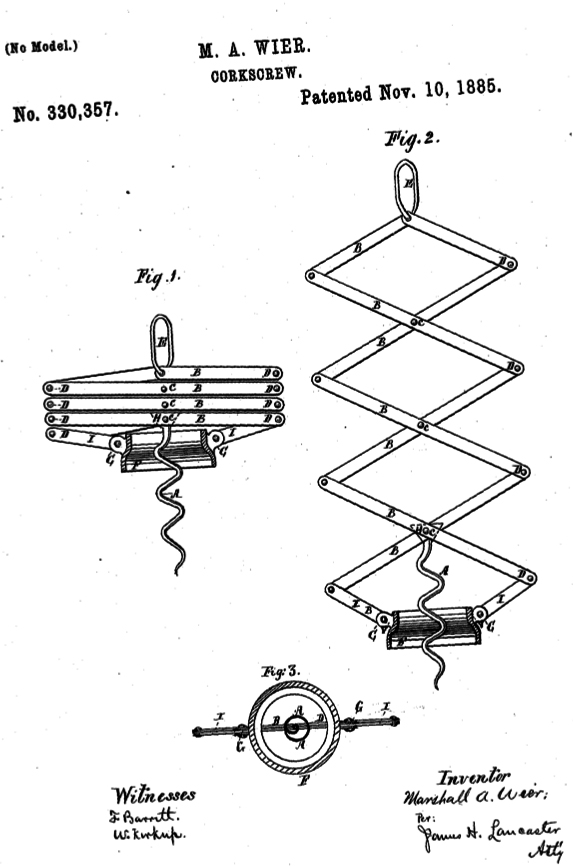
As described by Fletcher Wallis in British Corkscrews Patents from 1795 on p 100, there were five different designs based on the patent (Wier I-V). The designs were manufactured in Birmingham by James Heeley and Sons.
Here are some wonderful entries in the James Heeley and Sons catalogue of 1902 for the compound lever corkscrews.
Wier I (as per the patent)
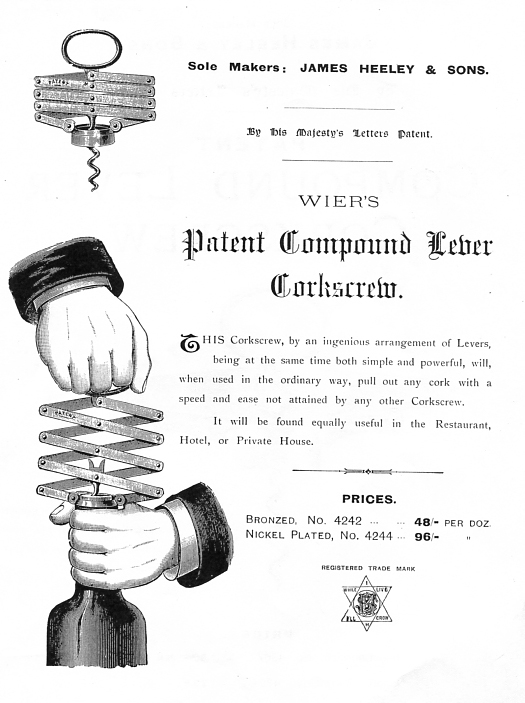
Wier II (Double Wier)
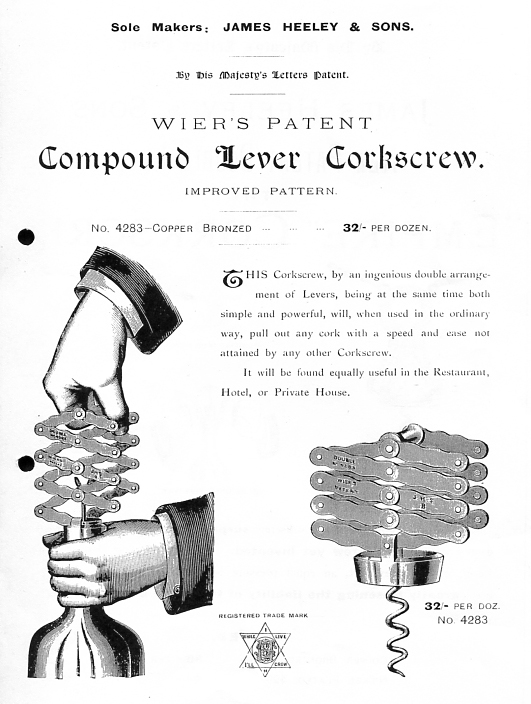
Wier III (adapted for ladies’ use)
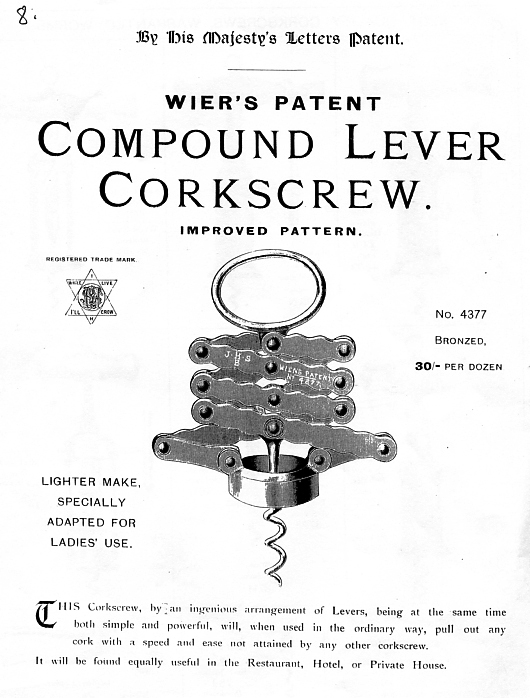
Another advertisement in the 1902 catalogue shown below is for a Wier V, similar to the Pullezi but a little smaller with the patent number 12804 (ie for the patent 10 arm version of Wier ) but the name Wier does not appear in the advertisement.
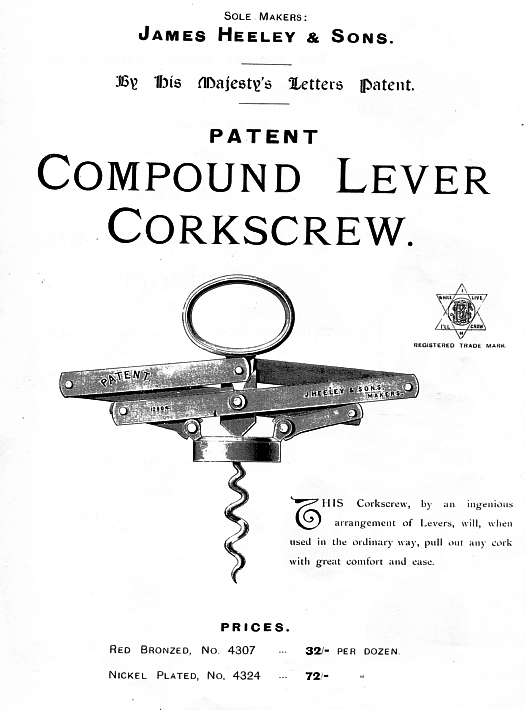
So who was Marshall Arthur Wier, the “father of the lazy tongs”?
Many Patents
Marshall Arthur Wier had many patents unrelated to corkscrews with the earliest taken out in England in 1867 with a co-inventor Arthur McNutt Wier. The address was Elm Lodge, Newton Road, Bayswater, County of Middlesex. This patent was for the “IMPROVEMENT IN PNEUMATIC TELEGRAPHS”/”improvements in signaling and indicating apparatus”; the significance of this will become apparent.
Census information
The 1881 UK census established that Marshall A Weir [sic] aged 32 was living in Penge, Surrey with his father Arthur McNutt Wier aged 65, his mother Margaret aged 55 and sister Lillie R aged 22. So the co-patentee with Marshall was his father and Marshall was aged about 18 years when he and his father took out the British patent in 1867.
With difficulty, the records for the Wier family were located in the 1871 census (Arthur was entered as Arthur McNutt Weis) and the 1891 and 1901 census as “Arthur M Heir”. With this information and snippets from the online site Nova Scotia Rootsweb, we have pieced together the following story on the Wier family. Of course the name McNutt helped to narrow the field somewhat!
Story of the Wier family
The Wier family came from Nova Scotia in Canada. Arthur McNutt Wier married Margaret Marshall on 26 August 1845 in Newport, Nova Scotia (Son Marshall was obviously given his mother’s family name). Both Arthur and Margaret were born in Halifax, Nova Scotia.
Arthur and wife lived in the northern central coastal port village of Horton Landing (near current Wolfville) in King’s County, Nova Scotia. They lived in a two-story house near the wharf and Arthur owned a shipyard and surrounding land. He had a schooner called Nonpareil built and registered in 1850. Son Marshall Arthur was born about 1847 in Horton.
On November 12 1855 the Canadian vessel Constantine registered in Quebec, was sold to Arthur McNutt Wier of Liverpool. (This vessel transported emigrants from Liverpool to New York and continued to do so until at least 1858). Hence Arthur was in Liverpool by 1855. In Liverpool, a second son was born about 1857 and a daughter about 1859. Sometime between 1859 and 1861 the family moved to London.
In 1861, Marshall now aged 14 was a scholar at a boarding school in Brighton with father Arthur and family, staying in the Westow Hill Queen’s Hotel, Norwood, Surrey. Arthur was a “shipping merchant”.
Ten years on, Marshall was living with his family in Paddington and his occupation was shown in the 1871 census as “telegraph employment”. Father Arthur aged 55 was now a “telegraph manufacturer”. No doubt Marshall was employed by his father.
In the 1881 census, Arthur now 65 years was described as a “retired shipowner” while Marshall aged 34 years was still living with his parents at Penge, Surrey and was an “engineer and inventor”. Three years on, they were living at No 3 Palace Grove, Upper Norwood, Surrey, the address given on the corkscrew patent of 1884 and taken out by Marshall.
Interestingly, at the same time as the corkscrew patent, Marshall was taking out a totally unrelated patent in England and the USA - for an improvement in automatic musical instruments.
For interest, here is the USA patented instrument!
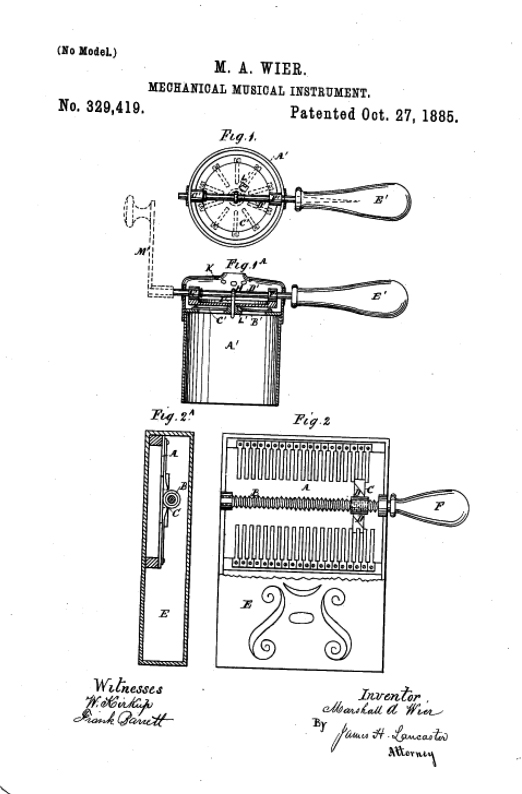
In 1887, Marshall took out a patent for an improved type-writer for secret writing. Years later in 1894, Marshall was the first inventor to develop the idea and to patent, a pneumatic typewriter.
While there were many other patents, 132 in total according to Watney and Babbidge, perhaps his corkscrew patent is the best known.
Father Arthur McNutt Wier died at age 87 years in 1908 at Kingston-on-the-Thames, Surrey and Marshall died in 1914 at age 65 years at the same address. In the 1911 census Marshall gave his occupation as “mechanical engineer”. Whether he had undertaken an engineering course is not clear. More likely he learnt his skills from his father.
Marshall did not marry. He did not have time to wed with so much time spent on his inventions. Perhaps red wine helped during his times of thought and concentration and this led to the development of the lazy tongs corkscrew patent. His patent was followed in 1902 by two British patents from Henry David Armstrong with key differences in the construction.

